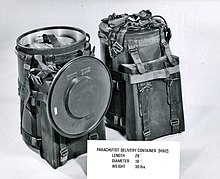


The Special Atomic Demolition Munition (SADM), also known as the XM129 and XM159 Atomic Demolition Charges, [1] and the B54 bomb [2] was a nuclear man-portable atomic demolition munition (ADM) system fielded by the US military from the 1960s to 1980s but never used in combat.
History and design
At the time of the weapon's development, the existing Atomic Demolition Munition (ADM) was the T-4 Atomic Demolition Munition. Its transport required 4 men, each carrying a 40-pound (18 kg) section of the weapon. [2]
Development began in June 1960 and an interim Mark 54 Mod 0 (now called the B54-0) weapon was put into production in April 1963. Production of the B54 Mod 1 SADM began in August 1964. The weapon was 12 inches (305 mm) in diameter, 18 inches (457 mm) long, and weighed 58.5 pounds (26.5 kg). It included the warhead, a fuzing and firing system with a mechanical timer, a ferroelectric firing set, and a sealed housing. The body was constructed with aluminum forgings and molded fiberglass, and foam-rubber insulation was used between the warhead and case. Dials were illuminated with tritium-phosphor paint for easy night-reading. A housing for underwater emplacement was provided that included external controls. [2]
The B54 Mod 2 started production in June 1965. The weapon was the same size as previous mods but now weighed more - 70 pounds (32 kg). [2]
The yield was estimated to be 10 to 1,000 tons of TNT (42 to 4,184 GJ). [3]
Use
Offensive use
ADM employment manuals describe the use of ADMs tactically in both offensive and defensive operations. [4]
In offensive operations, ADMs are described as being useful for improving flank and rear security of a unit, impeding counterattacks and assisting in enemy entrapment. [5]
Engineering and defensive use
ADM employment manuals describe the use of ADMs defensively for combat engineering purposes. Possible targets described include bridges, dams, canals, tunnels, airfields, railroad marshaling yards, ports and industrial plants, and power facilities. [6]
Extensive tables were provided to enable the selection of the correct yield for each particular target. These tables accounted for various employment particulars such as depth of burial, fallout considerations, and minimum safe separation distances between adjacent weapons and personnel. [7]
Suicide attack allegations
On December 27, 2018, the Green Bay Press-Gazette interviewed veteran Mark Bentley, who had trained for the Special Atomic Demolition Munition program to manually place and detonate the SADM. The report stated that he and other soldiers training for the program knew this was a suicide mission because either it would be unrealistic to outrun the timer on the bomb, or soldiers would be obligated to secure the site before the timer went off. [8]
However, employment manuals specifically describe the firing party and their guard retreating from the emplacement site, at which point security of the device is provided through a combination of passive security measures, including concealment, camouflage, and the use of decoys, as well as active security measures including booby traps, obstacles (such as concertina wire and landmines), and long-range artillery fire. [9] Further, the SADM included a Field Wire Remote Control System (FWRCS), a device that enabled the sending of safe/arm and firing signals to the weapon via a wire for safe remote detonation of the weapon. [10]
See also
- Green Light Teams
- W54 Warhead
- Medium Atomic Demolition Munition
- Suitcase nuclear device
- List of nuclear weapons
References
-
^
Semiannual Historical Report, Activities for the Period 1 July 1969 - 31 December 1968, Vol I (PDF) (Report). Headquarters Field Command, Defense Atomic Support Agency. p. 260. DASA-69-0492.
Archived (PDF) from the original on 4 June 2021. Retrieved 4 June 2021.
Operational Review of the XM-129/XM-159 Atomic Demolition Charge (B54 SADM)
- ^ a b c d History of the Mk 54 Weapon (Report). Sandia National Labs. February 1968. Archived from the original on 2021-05-22. Retrieved 2021-06-04.
- ^ Sublette, Carey (12 June 2020). "Complete List of All U.S. Nuclear Weapons". Retrieved 2021-03-24.
- ^ Employment of Atomic Demolition Munitions (ADM), Chapter 3.
- ^ Employment of Atomic Demolition Munitions (ADM), Page 3-1.
- ^ Employment of Atomic Demolition Munitions (ADM) (Report). Headquarters, Department of the Army. August 1971. FM 5-26.
- ^ Employment of Atomic Demolition Munitions (ADM), Chapter 6.
- ^ Paul Srubas, Green Bay (Wis.) Press-Gazette (January 7, 2019). "His job was to place atomic bombs. Place them, not drop them. Set the timer. Run like hell". Green Bay Press-Gazette. Archived from the original on May 20, 2020. Retrieved January 18, 2019 – via Associated Press.
- ^ Employment of Atomic Demolition Munitions (ADM), Pages 3-15 to 3-16.
- ^ Bartlett, J G (11 February 1964). Electromagnetic Radiation Susceptibility of the B54-0 (SADM) and the Field Wire Remote Control System (U) (Report). Sandia National Lab. Archived from the original on 25 May 2021. Retrieved 4 June 2021.
Bibliography
- Employment of Atomic Demolition Munitions (ADM) (PDF) (Report). Headquarters, Department of the Army. August 1971. FM 5-26.
- History of the Mk 54 Weapon (Report). Sandia National Labs. February 1968. Archived from the original on 2021-05-22. Retrieved 2021-06-04.